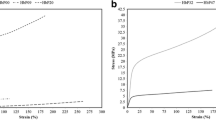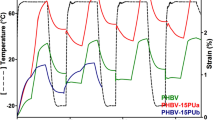Abstract
A series of polyurethanes (PUs) based on poly (tetramethylene glycol) (PTMG), poly (ethylene adipate) (PEA) diol, polycaprolactone (PCL) diol and castor oil (CO) were synthesized. The tensile, damping and thermal properties were studied systematically in terms of the composition and isocyanate index (R). Results showed that when R is 2, the PUs exhibit a relatively high tensile strength more than 30 MPa. The PTMG-PU, PCL-PU and PEA-PU show high elongation at break compared to the cross-linked CO-PU. When R is 1.5, tensile strengths decrease compared to R is 2. But, the elongations of PTMG-PU, PCL-PU and CO-PU increase. DMA analysis showed that the glass transition temperature (T g ) is increasing as the sequence of PTMG-PU, PCL-PU, PEA-PU and CO-PU. The T g of CO-PU is as high as 60.6 °C when R is 1.5 and 93.4 °C when R is 2. The T g ranges of the other linear PUs are between −50 and −12 °C. The damping temperature ranges of these PUs are relatively broad. Further, TG results showed the start degradation temperatures of them are approx 260 °C. These results show a good guidance to select a kind of PU when prepare the PU-polymer composites for given properties.











Similar content being viewed by others
References
Clemitson IR (2008) Castable polyurethane elastomers. CRC Press, New York
Petrovic ZS, Ferguson J (1991) Polyurethane elastomers. Prog Polym Sci 16:695–836
Krol P (2007) Synthesis methods, chemical structures and phase structures of linear polyurethanes. Prog Mater Sci 52:915–1015
Howarth GA (2003) Polyurethanes, polyurethane dispersions and polyureas: Past, present and future. Surf Coat IntPart B 86:111–118
Nakajima-Kambe T, Shigeno-Akutsu Y, Nomura N, Onuma F, Nakahara T (1999) Microbial degradation of polyurethane, polyester polyurethanes and polyether polyurethanes. Appl Microbiol Biotechnol 51:134–140
Spirkova M (2002) Polyurethane elastomers made from linear polybutadiene diols. J Appl Polym Sci 85:84–91
Oprea S (2011) Effect of the long chain extender on the properties of linear and castor oil cross-linked PEG-based polyurethane elastomers. J Mater Sci 46:2251–2258
Bae JY, Chung DJ, An JH, Shin DH (1999) Effect of the structure of chain extenders on the dynamic mechanical behaviour of polyurethane. J Mater Sci 34:2523–2527
Gite VV, Mahulikar PP, Hundiwale DG (2010) Preparation and properties of polyurethane coatings based on acrylic polyols and trimer of isophorone diisocyanate. Prog Org Coat 68:307–312
Yun SJ, Im H, Kim J (2011) Thermal conductivity and interconnectivity of hexamethylene diisocyanate contained polyurethane grafted multiwall carbon nanotube/polyurethane nanocomposite. Mater Trans 52:564–567
Barick AK, Tripathy DK (2011) Effect of organically modified layered silicate nanoclay on the dynamic viscoelastic properties of thermoplastic polyurethane nanocomposites. Appl Clay Sci 52:312–321
Zhang YC, Zhao YH, Kang MQ, Wang XK (2006) Review of polyurethane/layered silicate nanocomposites. Prog Chem 18:59–65
Siddaramaiah B, Shayan MB, Manjula KS, Ranganathaiah C, Rao GVN, Basavalingu B, Byrappa K (2010) Effect of zeolite particulate filler on the properties of polyurethane composites. J Polym Res 17:135–142
Lee Y, Kim BS, Hong JH, Park S, Kim H, Kim IS (2012) Enhanced mechanical properties and pre-tension effects of polyurethane (PU) nanofiber filaments prepared by electrospinning and dry twisting. J Polym Res 19: doi:10.1007/s10965-011-9774-4
Kim BS, Lee DS, Kim SC (1986) Polyurethane-polystyrene interpenetrating polymer networks: effect of photopolymerization temperature. Macromolecules 19:2589–2593
Matsui M, Munaro M, Akcelrud LC (2011) Chitin-polyurethane networks: correlations between physical properties and composition. J Polym Res 18:2255–2264
Chen CH, Chen WJ, Chen MH, Li YM (2000) Simultaneous full-interpenetrating polymer networks of blocked polyurethane and vinyl ester Part I. Polymer 41:7961–7967
Chen S, Wang Q, Wang T (2011) Physical properties of a high molecular weight hydroxyl-terminated polydimethylsiloxane modified castor oil based polyurethane/epoxy interpenetrating polymer network composites. Appl Phys A 103:1047–1052
Lin J, Yang QZ, Wen XF, Cai ZQ, Pi PH, Cheng J, Yang ZR (2011) Synthesis, characterization, and thermal stability studies of bisphenol-A type novolac epoxy-polyurethane coating systems for in-mould decoration ink applications. J Polym Res 18:1667–1677
Mosiewicki MA, Casado U, Marcovich NE, Aranguren MI (2012) Moisture dependence of the properties of composites made from tung oil based polyurethane and wood flour. J Polym Res 19: doi: 10.1007/s10965-011-9776-2
Kuta A, Hrdlicka Z, Strachota A, Spirkova M (2009) The influence of macrodiol type on the mechanical properties of polyurethane materials. Mater Manuf Processes 24:1214–1216
Chen S, Wang Q, Pei X, Wang T (2010) Dynamic mechanical properties of castor oil-based polyurethane/epoxy graft interpenetrating polymer network composites. J Appl Polym Sci 118:1144–1151
Bistricic L, Baranovic G, Leskovac M, Bajsic EG (2010) Hydrogen bonding and mechanical properties of thin films of polyether-based polyurethane-silica nanocomposites. Eur Polym J 46:1975–1987
Sophiea D, Klempner D, Sendijarevic V, Suthar B, Frisch KC (1994) Interpenetrating polymer networks as energy-absorbing materials. In: Klempner D, Sperling LH, Utracki LA (eds) Interpenetrating polymer networks. Amer Chemical Soc, New York, pp 39–75
Guo M (2002) Dynamic mechanical thermal analysis of polymer composites. Chemical Industry Press, Beijing
Acknowledgements
The financial supports from the National Science Foundation for Distinguished Young Scholars of China (Grant No. 51025517), the Innovative Group Foundation of NSFC (Grant No. 50721062), and the 973 Project of China (2007CB607606), the National Defense Basic Scientific Research Project (A1320110011) are duly acknowledged.
Author information
Authors and Affiliations
Corresponding author
Rights and permissions
About this article
Cite this article
Chen, S., Wang, Q. & Wang, T. Preparation, tensile, damping and thermal properties of polyurethanes based on various structural polymer polyols: effects of composition and isocyanate index. J Polym Res 19, 9994 (2012). https://doi.org/10.1007/s10965-012-9994-2
Received:
Accepted:
Published:
DOI: https://doi.org/10.1007/s10965-012-9994-2




